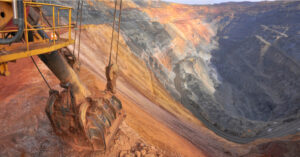
Sukhaya Balka mine (Kryvyi Rih, Dnipro region), part of Aleksandr Yaroslavsky’s DCH Group, increased crude iron ore production by 32%, or about 300 thousand tons, in the second quarter of this year.
The mine’s chief engineer, Igor Piltek, told DCH Steel’s corporate newspaper on Thursday that the production is short of workers in key job specialties. Therefore, the mine was forced to stop the technological process at the Frunze mine. The lack of a market for products also had a negative impact.
In addition, Yubileynaya mine is not yet being used to its full capacity, and the workforce is working depending on the situation with product shipments and the availability of qualified personnel.
“However, if we compare the performance of the first and second quarters of this year, we see an increase in production in the second quarter. Crude ore production increased by 32% to about 300 thousand tons, and commercial ore production by 42% (260 thousand tons) (…) This growth is primarily due to an increase in working hours. While at the beginning of the year the company’s team worked a reduced working week, in the second quarter, employees of the leading mining professions (sinking, mining, mine construction) returned to a full working week,” explained the chief engineer.
He also said that after the occupation of Mariupol and the destruction of Sukhoi Balka’s main consumer of ore, the company reoriented to another market: ore is being sold to Western partners, metal producers. The mine’s ore is consumed by steel mills in Slovakia, the Czech Republic, Hungary and Serbia.
“This spring, sales volumes increased, but in the summer, due to the crisis in the steel industry, we are seeing a decline. The shutdown of four blast furnaces at European steel mills reduced the need for raw materials. Sales volumes of the mine’s products decreased. We hope that the situation will improve in September,” said Piltek.
Commenting on the water situation, the chief engineer pointed to the shortage of water after the destruction of the Kakhovka hydroelectric power station. In particular, the lack of water affects the operation of the Central Compressor Station: the unit usually uses about 300 cubic meters of water, but in the current conditions, given the lack of resources, the company has developed a number of measures to reduce consumption. Significant savings have been made at Frunze mine, the industrial site of Yubileynaya mine, and auxiliary units. Water consumption was reduced by 30%.
It is also noted that difficulties with the company’s energy supply are expected in winter, so this year a new powerful generator was installed at Tsentralnaya mine to ensure the withdrawal of miners from the mine in case of a power outage.
“In the near future, we expect to receive five 20 kW generators to create a reserve and meet the needs of surface facilities,” added Piltek.
Sukha Balka mine is one of the leading mining companies in Ukraine. It produces iron ore by underground mining. The mine includes Yubileynaya and Frunze mines. DCH Group acquired the mine from Evraz Group in May 2017.

Mining companies in Ukraine in January-May this year, the export of iron ore raw materials (iron ore) in physical terms reduced by 55% compared to the same period last year – up to 6 million 846.487 thousand tons.
According to the statistics, released by the State Customs Service (SCS), over the period the currency proceeds from the export of iron ore amounted to $752.472 million.
Exports of iron ore products were mainly to Slovakia (29.08% in monetary terms), Czech Republic (25.06%) and Poland (21.42%).
During the first five months of this year, Ukraine imported iron ore products for $42 thousand in total volume of 68 tons. During this period, imports were carried out from Norway (57.14%), Italy (40.48%) and Sweden (2.38%).
As reported, in 2022, Ukraine reduced the export of iron ore products in kind by 45.9% compared to 2021 – up to 23 million 984.623 tons, foreign exchange earnings decreased by 57.8% to $2 billion 912.974 million.
Exports of iron ore products was carried out mainly to Slovakia (19.23% in monetary terms), Czech Republic (17.32%) and Poland (16.49%).
Last year Ukraine imported iron ore to the amount of $65 thousand in total 101 tons, while in 2021 – $184 thousand in the amount of 1.202 tons.
Imports were carried out from Norway (36.92%), the Netherlands (27.69%) and the UK (16.92%).

In January-April this year, mining companies in Ukraine reduced the export of iron ore raw materials (iron ore) in physical terms by 2.44 times compared to the same period last year – up to 5 million 324.686 thousand tons.
According to the statistics, released by the State Customs Service (SCS), over the period the currency proceeds from the export of iron ore amounted to $ 591.5 million, which is 2.7 times less than over the same period last year.
The export of iron ore products was carried out mainly to Slovakia (27.37% of supplies in monetary terms), Czech Republic (25.82%) and Poland (24.04%).
In the first four months of this year, Ukraine imported iron ore products for $41 thousand and a total of 67 tons, whereas in January-April 2022 there were imported iron ore products for $1 thousand and a total of 2 tons.
Imports for this period came from Norway (58.54%) and Italy (41.46%).
As reported, in 2022, Ukraine has reduced the export of iron ore products in kind by 45.9% compared to the previous year – up to 23 million 984.623 tons, foreign exchange earnings decreased by 57.8% to $2 billion 912.974 million.
Exports of iron ore products was carried out mainly to Slovakia (19.23% in monetary terms), Czech Republic (17.32%) and Poland (16.49%).
Last year Ukraine imported iron ore to the amount of $65 thousand in total 101 tons, while in 2021 – $184 thousand in the amount of 1.202 tons.
Imports were carried out from Norway (36.92%), the Netherlands (27.69%) and the UK (16.92%).

Sukhaya Balka” mine (Krivoy Rog, Dnipropetrovsk region), which belongs to Alexander Yaroslavskyy`s DCH group, put into operation a new block 128-134 for iron ore extraction in March this year.
According to a corporate newspaper DCH Steel, the block was put into operation on March 6, the first explosion took place there on March 11, and on March 15 the first ore was “worked up”.
As it is specified, the working unit from “Golovny” deposits is located at a depth of minus 1420 meters. Lava thickness is about 130 thousand ores. Iron content is 61%.
The preparatory work to put the new longwall face into operation lasted 4.5 months. It is planned to mine the new block within four months.
The Sukhaya Balka mine is one of the leading enterprises of mining industry in Ukraine. It extracts iron ore by underground mining. The mine includes the Yubileynaya and Frunze mines. Frunze. DCH Group acquired the mine from Evraz Group in May 2017.

Mining companies in Ukraine in January this year, reduced the export of iron ore raw materials (iron ore) in physical terms by 75.9% compared to the same period last year – up to 927.433 thousand tons.
According to the statistics, released by the State Customs Service (SCS), during this period, foreign currency revenues from exports of iron ore decreased by 67% to $110.857 million.
Exports of iron ore products were mainly to Slovakia (28.65% of supplies in monetary terms), the Czech Republic (28.55%) and Austria (20.06%).
Last month Ukraine imported iron ore products for $1 thousand in the total amount of 2 tons, whereas in January-2021 there were imported also $1 thousand in the amount of 1 thousand tons. Imports in January-2023 were from Italy (100%).
As reported, in 2022, Ukraine reduced exports of iron ore products in physical terms by 45.9% compared to the previous year – up to 23 million 984.623 thousand tons, foreign exchange earnings decreased by 57.8% to $2 billion 912.974 million.
Exports of iron ore products was carried out mainly to Slovakia (19.23% in monetary terms), Czech Republic (17.32%) and Poland (16.49%).
Last year Ukraine imported iron ore to the amount of $65 thousand in total 101 tons, while in 2021 – $184 thousand in the amount of 1.202 tons.
Imports were carried out from Norway (36.92%), the Netherlands (27.69%) and the UK (16.92%).